
Here is a list of 15 films that got lukewarm to good reviews in their day but really have a resurgent cinephile following in contemporary years. Or another way to put it, they’re major classics now even if they weren’t then:
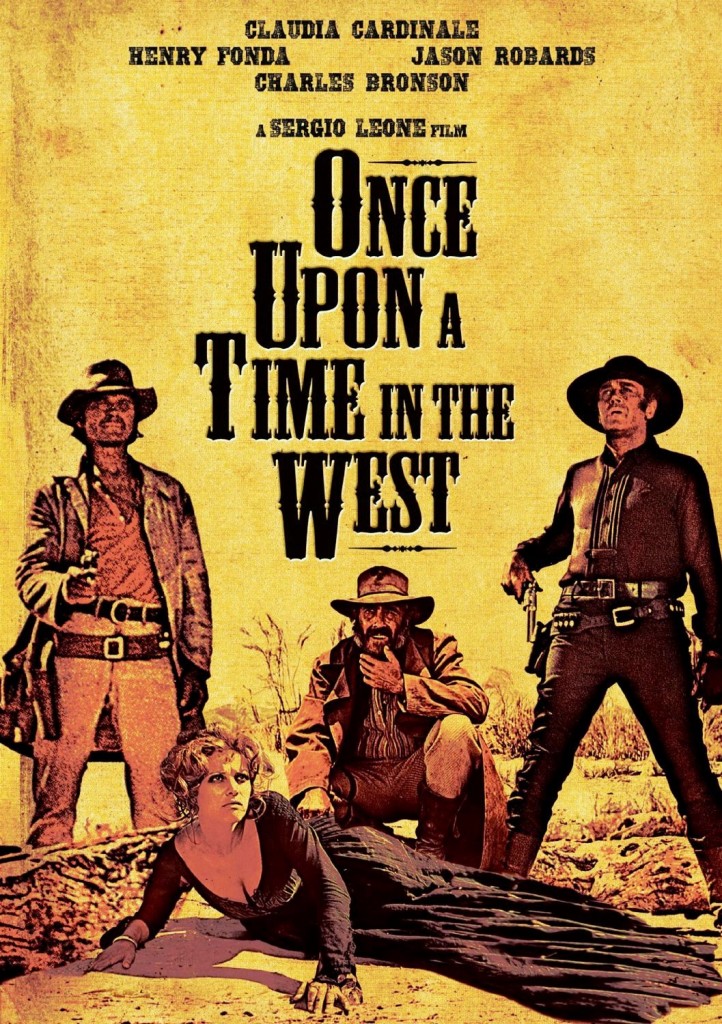 1. Once Upon a Time in the West (1968, 166 Minutes, PG-13) – An epic western about desperate businessmen and gunfighters’ dreams and follies, how rare is that? Sergio Leone often goes for pure visual storytelling without dialogue. At the time, it was thought as an overblown western with a thin plot, possibly thought of as thin only because the first hour sets up mood and circumstance instead of throwing expository plot information at us. Henry Fonda in his first bad guy role, Charles Bronson as the laconic hero seeking mysterious revenge and Claudia Cardinale as the beauty just trying to stake a reasonable life worth living. Greatest film critic Roger Ebert gave it two and a half stars but later hinted that he’d been wrong about it. Now it’s regarded by a mass consensus as an idiosyncratic western masterpiece.
1. Once Upon a Time in the West (1968, 166 Minutes, PG-13) – An epic western about desperate businessmen and gunfighters’ dreams and follies, how rare is that? Sergio Leone often goes for pure visual storytelling without dialogue. At the time, it was thought as an overblown western with a thin plot, possibly thought of as thin only because the first hour sets up mood and circumstance instead of throwing expository plot information at us. Henry Fonda in his first bad guy role, Charles Bronson as the laconic hero seeking mysterious revenge and Claudia Cardinale as the beauty just trying to stake a reasonable life worth living. Greatest film critic Roger Ebert gave it two and a half stars but later hinted that he’d been wrong about it. Now it’s regarded by a mass consensus as an idiosyncratic western masterpiece.
 2. The Gambler (1974, 111 Minutes, R) – James Caan tries to be a super stud by gambling with money he doesn’t have. Critics liked it but saw it as only a gambling movie, as if that subject limited its worth. A couple decades later, critics and cinephiles realize the ’70’s was a golden era for radical filmmaking, and new appreciation is given for this pic’s grit and intelligence. Seriously, why was “Mean Streets” immediately embraced the year before but not this? Here’s also a protagonist that skirts excitement in narrowly dodging highest stakes of danger with the bookies and company he keeps. Today, the dark ending is something of a shocker. Former review.
2. The Gambler (1974, 111 Minutes, R) – James Caan tries to be a super stud by gambling with money he doesn’t have. Critics liked it but saw it as only a gambling movie, as if that subject limited its worth. A couple decades later, critics and cinephiles realize the ’70’s was a golden era for radical filmmaking, and new appreciation is given for this pic’s grit and intelligence. Seriously, why was “Mean Streets” immediately embraced the year before but not this? Here’s also a protagonist that skirts excitement in narrowly dodging highest stakes of danger with the bookies and company he keeps. Today, the dark ending is something of a shocker. Former review.
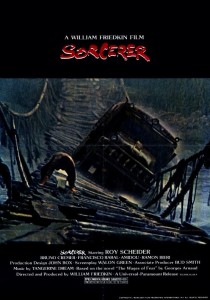 3. Sorcerer (1977, 121 Minutes, PG) – This heady, machismo action film (too much set-up, too much brainy plot! was the complaint) was released on June 24, 1977 while “Star Wars” had been released on May 25 and still packing in repeat business. This remake of the just as robust French classic “Wages of Fear” (1953) is known today for two things: Mesmerizing jungle scenery that is without par, and an uncommonly intelligent and anti-formula script for an action film. The plot: Roy Scheider is one of four men who have to navigate a transport truck over South American mountains while carrying lethal nitroglycerin that if banged up can blow them all to smithereens. Perfectionist William Friedkin, whose “The Exorcist” and “The French Connection” solidified him as a major director, has said this is the only movie he’s made where he wouldn’t re-do a single shot. In recent years, it is gaining classic status thanks to Quentin Tarantino’s top ten of all time declaration and other disciple critics. Former review.
3. Sorcerer (1977, 121 Minutes, PG) – This heady, machismo action film (too much set-up, too much brainy plot! was the complaint) was released on June 24, 1977 while “Star Wars” had been released on May 25 and still packing in repeat business. This remake of the just as robust French classic “Wages of Fear” (1953) is known today for two things: Mesmerizing jungle scenery that is without par, and an uncommonly intelligent and anti-formula script for an action film. The plot: Roy Scheider is one of four men who have to navigate a transport truck over South American mountains while carrying lethal nitroglycerin that if banged up can blow them all to smithereens. Perfectionist William Friedkin, whose “The Exorcist” and “The French Connection” solidified him as a major director, has said this is the only movie he’s made where he wouldn’t re-do a single shot. In recent years, it is gaining classic status thanks to Quentin Tarantino’s top ten of all time declaration and other disciple critics. Former review.
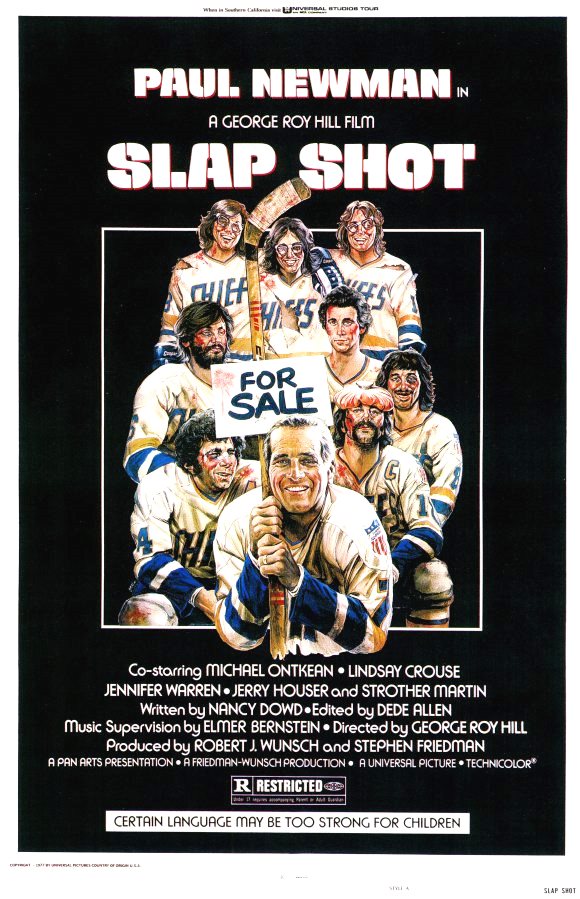 4. Slap Shot (1977, 123 Minutes, R) – The complaint was it was only a foul-mouthed and guts-spewing hockey film, and anything this rowdy and entertaining can’t possibly be taken seriously. The grubby, grey tones cinematography was a good choice for this middle-class story of minor leaguers about to lose their team because the owner doesn’t think they have resale value. It didn’t bode well with prudish critics that there’s a man’s naked ass on the rink in the finale. Boo hoo if you’re one of them not laughing. Paul Newman considered this his favorite of all films. Gene Siskel admitted he was wrong about his initial mediocre review and considered it later as a favorite comedy. We’re all watching it and recommending it as the ultimate hockey movie some forty years later.
4. Slap Shot (1977, 123 Minutes, R) – The complaint was it was only a foul-mouthed and guts-spewing hockey film, and anything this rowdy and entertaining can’t possibly be taken seriously. The grubby, grey tones cinematography was a good choice for this middle-class story of minor leaguers about to lose their team because the owner doesn’t think they have resale value. It didn’t bode well with prudish critics that there’s a man’s naked ass on the rink in the finale. Boo hoo if you’re one of them not laughing. Paul Newman considered this his favorite of all films. Gene Siskel admitted he was wrong about his initial mediocre review and considered it later as a favorite comedy. We’re all watching it and recommending it as the ultimate hockey movie some forty years later.
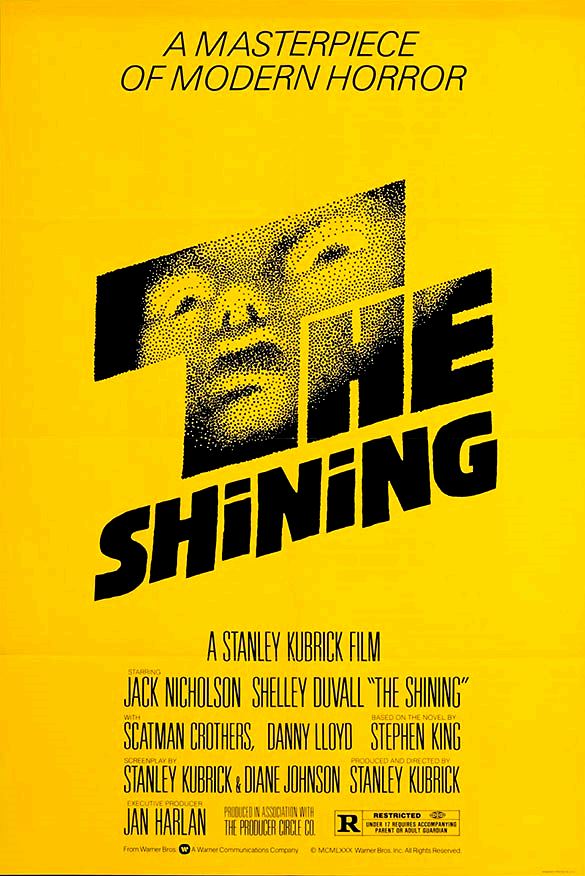 5. The Shining (1980, 143 Minutes, R) – The best horror film ever made and probably the best one there will ever be. It’s my favorite film of this article. It’s kind of ridiculous that I have to list it at all, but in truth, many baffled critics found it incoherent and strewn with red herrings. The Razzies had nominated it for Worst Actress and Worst Director. Devotees over the years now revere it for its supernatural elements, its haunted symbolism, its hypnotic camerawork that spells delirium and claustrophobia. I see something else: A parable of the world’s most loveless marriage. This is the Stanley Kubrick film that scrambles the brain the longest and after years of dissecting it I’m starting to see more disturbing subliminal touches than I’ve ever seen before. It’s all so endlessly fascinating. Former review.
5. The Shining (1980, 143 Minutes, R) – The best horror film ever made and probably the best one there will ever be. It’s my favorite film of this article. It’s kind of ridiculous that I have to list it at all, but in truth, many baffled critics found it incoherent and strewn with red herrings. The Razzies had nominated it for Worst Actress and Worst Director. Devotees over the years now revere it for its supernatural elements, its haunted symbolism, its hypnotic camerawork that spells delirium and claustrophobia. I see something else: A parable of the world’s most loveless marriage. This is the Stanley Kubrick film that scrambles the brain the longest and after years of dissecting it I’m starting to see more disturbing subliminal touches than I’ve ever seen before. It’s all so endlessly fascinating. Former review.
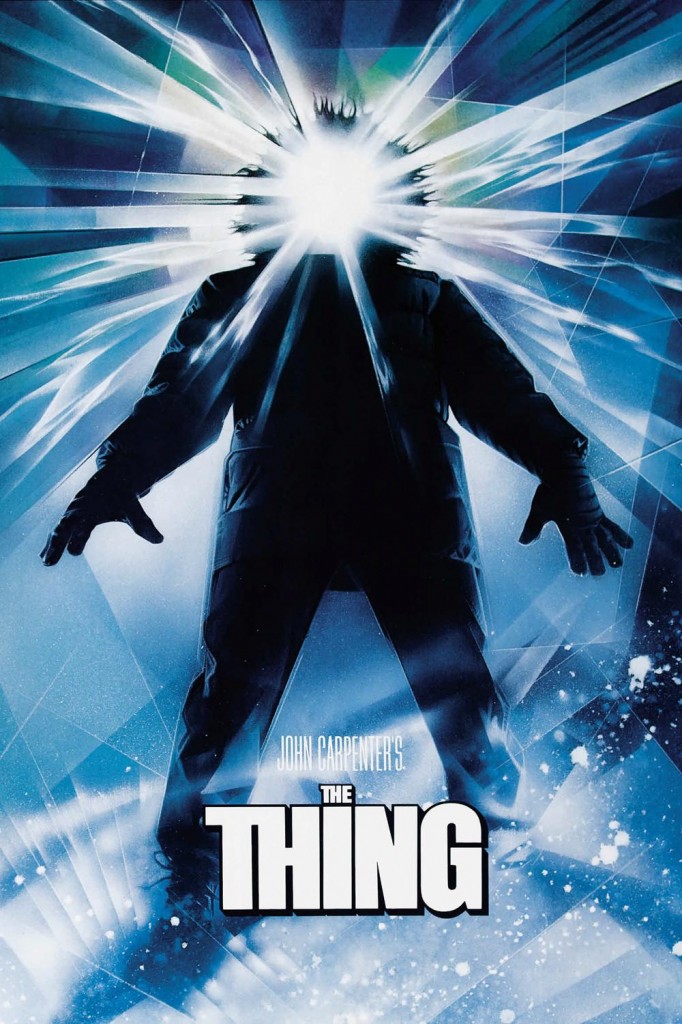 6. The Thing (1982, 109 Minutes, R) – No character development, many groused. If those critics could have only anticipated no character development in a glut of movies regularly thirty years later, geez, they must all be having temper tantrums now. That complaint to me still makes no sense. We’re trapped in an isolated research lab in Antarctica and it is too damn freezing for anybody to be extra friendly. It makes story sense that Kurt Russell, David Clennon, T.K. Carter, Keith David, Richard Dysart, Donald Moffat, Wilford Brimley and others must wish they had been more friendly with each other now that an extra-terrestrial killer parasite is imitating them. This John Carpenter entry is a scary film the first six times you watch it. Former review.
6. The Thing (1982, 109 Minutes, R) – No character development, many groused. If those critics could have only anticipated no character development in a glut of movies regularly thirty years later, geez, they must all be having temper tantrums now. That complaint to me still makes no sense. We’re trapped in an isolated research lab in Antarctica and it is too damn freezing for anybody to be extra friendly. It makes story sense that Kurt Russell, David Clennon, T.K. Carter, Keith David, Richard Dysart, Donald Moffat, Wilford Brimley and others must wish they had been more friendly with each other now that an extra-terrestrial killer parasite is imitating them. This John Carpenter entry is a scary film the first six times you watch it. Former review.
 7. Runaway Train (1985, 111 Minutes, R) – There’s a little bit of bad ’80’s pump you up music, but that goes away fast. Rare for an action movie, Jon Voight and Eric Roberts grabbed Oscar nominations for playing two escaped Alaskan convicts who hitch on a four-locomotive train that loses its driver. It was based on an unused Akira Kurosawa screenplay, which was honestly better suited for an American studio. Still, for a long time, “Runaway” was thought of as just an action movie while it’s also an existential tragedy. When critic Michael Phillips took over Ebert’s seat on the “At the Movies” television program, he called it the most underrated movie of the 1980’s. The director was Andrei Konchalovsky, but I’m afraid he was a one-hit wonder. Former review.
7. Runaway Train (1985, 111 Minutes, R) – There’s a little bit of bad ’80’s pump you up music, but that goes away fast. Rare for an action movie, Jon Voight and Eric Roberts grabbed Oscar nominations for playing two escaped Alaskan convicts who hitch on a four-locomotive train that loses its driver. It was based on an unused Akira Kurosawa screenplay, which was honestly better suited for an American studio. Still, for a long time, “Runaway” was thought of as just an action movie while it’s also an existential tragedy. When critic Michael Phillips took over Ebert’s seat on the “At the Movies” television program, he called it the most underrated movie of the 1980’s. The director was Andrei Konchalovsky, but I’m afraid he was a one-hit wonder. Former review.
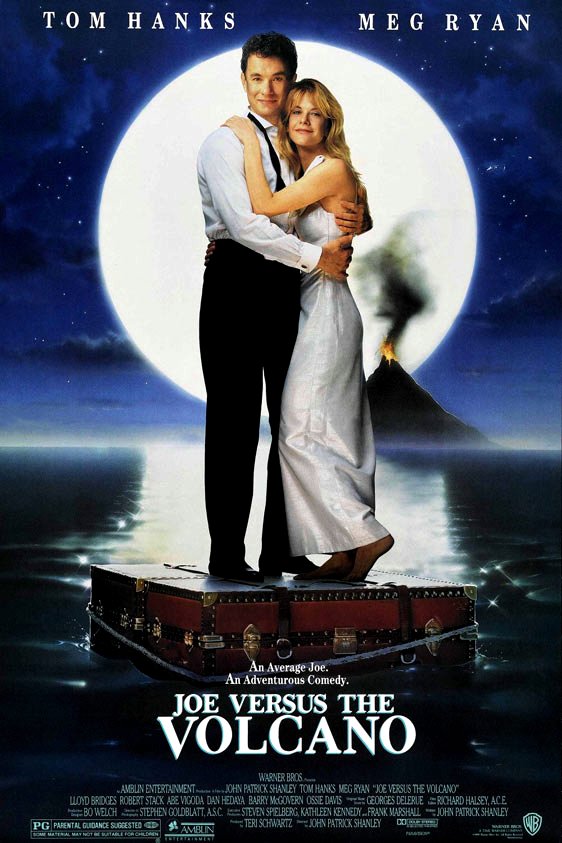 8. Joe vs. the Volcano (1990, 102 Minutes, PG) – The best American movie of 1990 that wasn’t “GoodFellas,” this truly marvelous comedy has Tom Hanks as a working stiff who learns he has six months to live, and sets out for a world travel adventure. His boss will let him live rich for the remainder of his life if he agrees to jump into a volcano at the end of the line, and Meg Ryan is the love interest who discourages him from taking the leap. Time Magazine film critic Richard Schickel named this his favorite guilty pleasure, but recalls how at its release a few slammed it as being a toneless oddity. Not toneless at all, it’s simply a very whimsical fairytale that is simply incomparable. Directed by John Patrick Shanley. Former review.
8. Joe vs. the Volcano (1990, 102 Minutes, PG) – The best American movie of 1990 that wasn’t “GoodFellas,” this truly marvelous comedy has Tom Hanks as a working stiff who learns he has six months to live, and sets out for a world travel adventure. His boss will let him live rich for the remainder of his life if he agrees to jump into a volcano at the end of the line, and Meg Ryan is the love interest who discourages him from taking the leap. Time Magazine film critic Richard Schickel named this his favorite guilty pleasure, but recalls how at its release a few slammed it as being a toneless oddity. Not toneless at all, it’s simply a very whimsical fairytale that is simply incomparable. Directed by John Patrick Shanley. Former review.
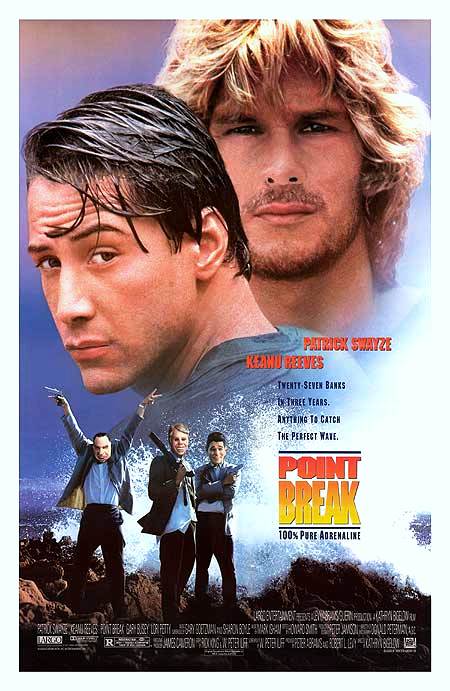 9. Point Break (1991, 122 Minutes, R) – Bank robbers vs. an FBI agent fresh out of the academy, or in another way, Patrick Swayze versus Keanu Reeves. Two stars often dismissed as hunky and not talented, but I say they work because Swayze and Reeves have a wild youth to them. And how about those three endings? What seemed silly in the year of its release is deemed seriously awesome now. An action film with no computerized special effects, blood-rushing stuntwork, dazzling camerawork, astonishing skydiver shots and a plot that holds water, well, well, well… They don’t make them like this anymore, and it’s an early Kathryn Bigelow (“The Hurt Locker”) movie that proves her flair for kinetic action that flows. Watch it again, and those three “endings” are congruous.
9. Point Break (1991, 122 Minutes, R) – Bank robbers vs. an FBI agent fresh out of the academy, or in another way, Patrick Swayze versus Keanu Reeves. Two stars often dismissed as hunky and not talented, but I say they work because Swayze and Reeves have a wild youth to them. And how about those three endings? What seemed silly in the year of its release is deemed seriously awesome now. An action film with no computerized special effects, blood-rushing stuntwork, dazzling camerawork, astonishing skydiver shots and a plot that holds water, well, well, well… They don’t make them like this anymore, and it’s an early Kathryn Bigelow (“The Hurt Locker”) movie that proves her flair for kinetic action that flows. Watch it again, and those three “endings” are congruous.
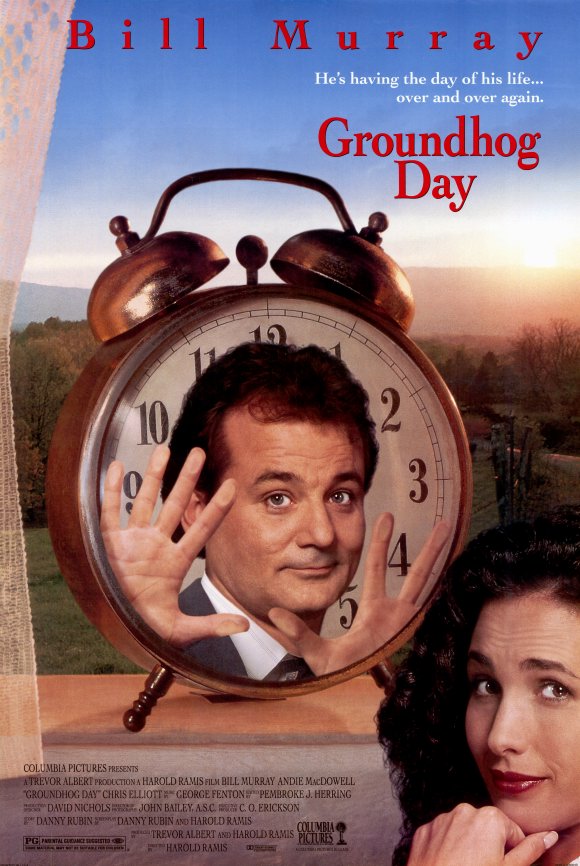 10. Groundhog Day (1993, 101 Minutes, PG) – The New York film critics got it more than everybody else by awarding it second place for the year’s Best Screenplay. To many, it was merely good and nothing more at the time. That was until it became the movie everybody saw a dozen times (Ebert initially had a three-star review until he later included it as an entry into his Great Movies series). You know the plot of this popular entertainment by now, Bill Murray is a cranky weatherman who re-lives February 2 over and over again in a time loop until he finds one way out (it ain’t suicide). It’s incredibly funny every time with resonant big philosophical questions about life. Former review.
10. Groundhog Day (1993, 101 Minutes, PG) – The New York film critics got it more than everybody else by awarding it second place for the year’s Best Screenplay. To many, it was merely good and nothing more at the time. That was until it became the movie everybody saw a dozen times (Ebert initially had a three-star review until he later included it as an entry into his Great Movies series). You know the plot of this popular entertainment by now, Bill Murray is a cranky weatherman who re-lives February 2 over and over again in a time loop until he finds one way out (it ain’t suicide). It’s incredibly funny every time with resonant big philosophical questions about life. Former review.
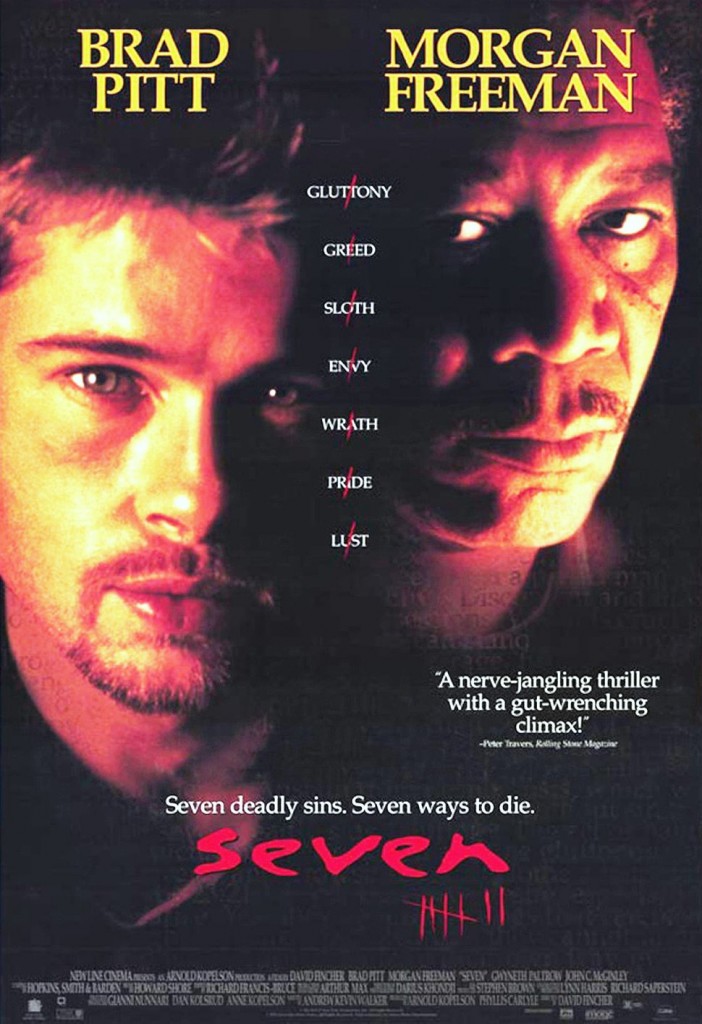 11. Seven (1995, 127 Minutes, R) – It shocked big business at the box office, meaning it made money because of its gotta see it “shock” value. The grisly serial killer tale was seen as gripping storytelling, with a particular dark and dank look by David Fincher that made for sleazoid art but not particularly serious art. Look years later, it holds a legitimate claim that it hearkens Dante’s “Inferno.” Plus, this is one of Morgan Freeman’s great performances, as a wise cop of muted jadedness who feels obliged to mentor the young Brad Pitt cop who is too cocky and without professional acumen. Freeman with his discerning insight is the only one that understands the horrid internal nature of the John Doe serial killer. As for Fincher, at the time he was still an unproven director with only the mixed result of “Alien 3” behind him. It took time to be convinced Fincher consciously knew what he was doing all along.
11. Seven (1995, 127 Minutes, R) – It shocked big business at the box office, meaning it made money because of its gotta see it “shock” value. The grisly serial killer tale was seen as gripping storytelling, with a particular dark and dank look by David Fincher that made for sleazoid art but not particularly serious art. Look years later, it holds a legitimate claim that it hearkens Dante’s “Inferno.” Plus, this is one of Morgan Freeman’s great performances, as a wise cop of muted jadedness who feels obliged to mentor the young Brad Pitt cop who is too cocky and without professional acumen. Freeman with his discerning insight is the only one that understands the horrid internal nature of the John Doe serial killer. As for Fincher, at the time he was still an unproven director with only the mixed result of “Alien 3” behind him. It took time to be convinced Fincher consciously knew what he was doing all along.
 12. Gattaca (1997, 106 Minutes, PG-13) – It had solid and admirable reviews when it came out, but now it is often cited and referenced. Genetic engineering has become a major issue in today’s times, and here’s the sci-fi film that predates before it became popular topic. I always have thought Ethan Hawke and especially Uma Thurman were terrific, the former born with normal flawed genes and the latter born with genetically engineered genes to siphon perfection. I still think Jude Law gives a poor performance as the genetically designed NASA guy who has become paralyzed and now shares his DNA with Hawke’s invalid. Still, this is a remarkable flick.
12. Gattaca (1997, 106 Minutes, PG-13) – It had solid and admirable reviews when it came out, but now it is often cited and referenced. Genetic engineering has become a major issue in today’s times, and here’s the sci-fi film that predates before it became popular topic. I always have thought Ethan Hawke and especially Uma Thurman were terrific, the former born with normal flawed genes and the latter born with genetically engineered genes to siphon perfection. I still think Jude Law gives a poor performance as the genetically designed NASA guy who has become paralyzed and now shares his DNA with Hawke’s invalid. Still, this is a remarkable flick.
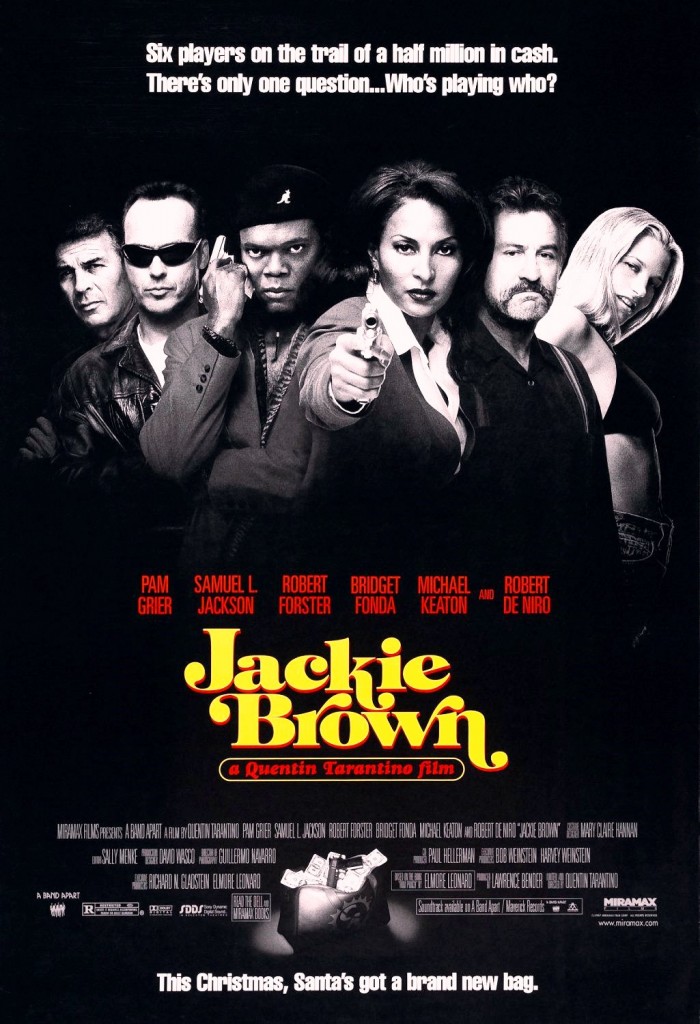 13. Jackie Brown (1997, 155 Minutes, R) – I now rank this as Tarantino’s third best, behind “Pulp Fiction” and “Inglorious Basterds.” I don’t know why it was felt as some kind of placeholder until another major “Pulp” kind of movie came along, but years later, you love “Jackie Brown” on its own terms. You also look at Samuel L. Jackson’s entire body of work, and here as a streetwise gunrunner who talks in circles – embedding subtle threats in his language – well, this could be his greatest performance. Not a single award went to Jackson for his work as Ordell. The behind the scenes comeback story fawned over character actor Robert Forster, who did get an Oscar nomination. The language and double-crossing in the story is more than “moderately entertaining” as critics at large said, see it anytime these days and it’s a brilliant, scheming knock-out. Former review.
13. Jackie Brown (1997, 155 Minutes, R) – I now rank this as Tarantino’s third best, behind “Pulp Fiction” and “Inglorious Basterds.” I don’t know why it was felt as some kind of placeholder until another major “Pulp” kind of movie came along, but years later, you love “Jackie Brown” on its own terms. You also look at Samuel L. Jackson’s entire body of work, and here as a streetwise gunrunner who talks in circles – embedding subtle threats in his language – well, this could be his greatest performance. Not a single award went to Jackson for his work as Ordell. The behind the scenes comeback story fawned over character actor Robert Forster, who did get an Oscar nomination. The language and double-crossing in the story is more than “moderately entertaining” as critics at large said, see it anytime these days and it’s a brilliant, scheming knock-out. Former review.
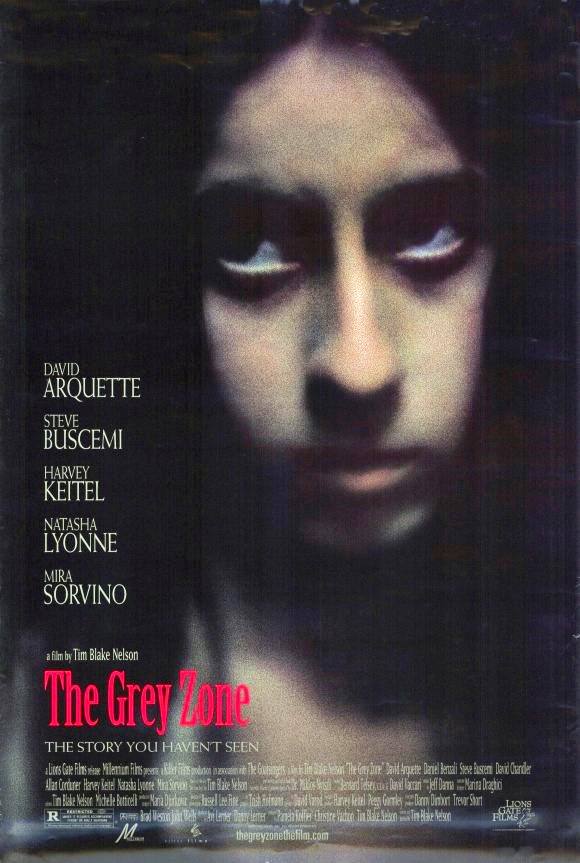 14. The Grey Zone (2002, 108 Minutes, R) – The despairing concentration camp Holocaust film too grim and without a conventional catharsis (to some). All the characters know they are going to die, they can put off death for a few weeks, and perhaps blow up one of the Nazi’s crematoriums as redemption. Critics lambasted the stylized philosophical dialogue that happens between camp inmates. Some like me say that this is how people in life and death matters would speak if they poured their heart and soul into their words. “The Pianist,” a worthy WWII film by Roman Polanski, won three Oscars and had an ultimately triumphant tale that overshadowed this Tim Blake Nelson film. But in truth, this is now the Holocaust film that haunts as much as “Schindler’s List.” Former review.
14. The Grey Zone (2002, 108 Minutes, R) – The despairing concentration camp Holocaust film too grim and without a conventional catharsis (to some). All the characters know they are going to die, they can put off death for a few weeks, and perhaps blow up one of the Nazi’s crematoriums as redemption. Critics lambasted the stylized philosophical dialogue that happens between camp inmates. Some like me say that this is how people in life and death matters would speak if they poured their heart and soul into their words. “The Pianist,” a worthy WWII film by Roman Polanski, won three Oscars and had an ultimately triumphant tale that overshadowed this Tim Blake Nelson film. But in truth, this is now the Holocaust film that haunts as much as “Schindler’s List.” Former review.
 15. Burn After Reading (2008, 96 Minutes, R) – The Coens had just won Oscars for “No Country for Old Men” and the thought-process was this next one is just a breathable lark for them to make. This tale of CIA officials, analysts, spies and dupes entangled in Washington, is one of the most endlessly amusing movies of dry humor that one can’t get tired of. I got it in 2008, placing it as my number #2 film of the year. My taste has changed slightly as my Top Five of 2008 would now read like this: “The Dark Knight,” “Tropic Thunder,” “Slumdog Millionaire,” “Burn After Reading,” “The Wrestler.” Of those five, the Coens milk the most entertainment out of no sweat, effortless entertainment. Former review.
15. Burn After Reading (2008, 96 Minutes, R) – The Coens had just won Oscars for “No Country for Old Men” and the thought-process was this next one is just a breathable lark for them to make. This tale of CIA officials, analysts, spies and dupes entangled in Washington, is one of the most endlessly amusing movies of dry humor that one can’t get tired of. I got it in 2008, placing it as my number #2 film of the year. My taste has changed slightly as my Top Five of 2008 would now read like this: “The Dark Knight,” “Tropic Thunder,” “Slumdog Millionaire,” “Burn After Reading,” “The Wrestler.” Of those five, the Coens milk the most entertainment out of no sweat, effortless entertainment. Former review.
I could have easily reached further back to discuss “Make Way for Tomorrow” (1937), “The Wizard of Oz” (1939), “It’s a Wonderful Life” (1946), “Vertigo” (1958), “Bonnie and Clyde” (1967). Boy, that those classics got bad reviews in their day is truly, truly shocking. THREE WEEKS AFTER POST: I will make the confession that I overlooked “Gremlins 2: The New Batch” (1990) which should have been included in discussion. I will consider working in a revision at a later date.




